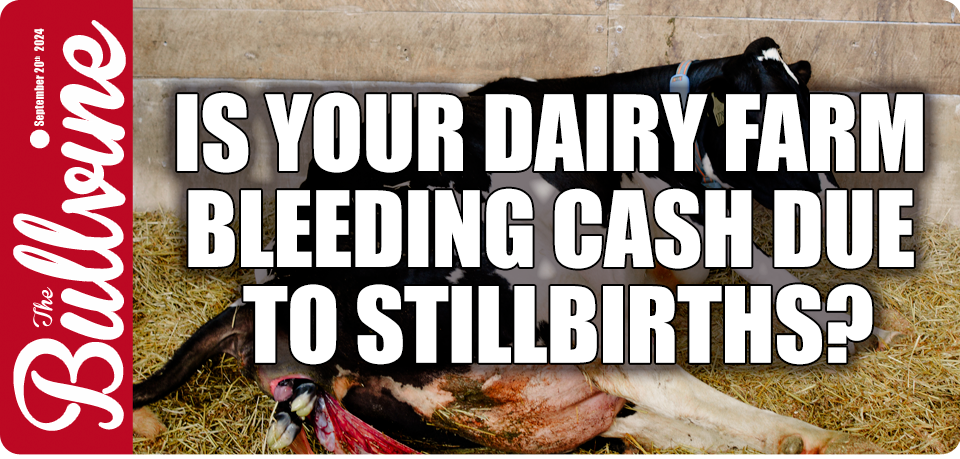Is your dairy farm losing money because of stillbirths? Uncover the hidden costs and learn how to safeguard your profits in our expert guide. Read on to find out more.
Are stillbirths stealthily depleting your dairy farm’s resources and compromising your livelihood? You are not alone. Many dairy producers need help with the terrible reality of losing calves before they can survive. This problem is critical to your farm’s production and significantly impacts your bottom line. “Losing a calf at birth is like losing a future dairy cow and the potential it holds for the herd’s performance and profitability.” Each lost calf represents a considerable loss in milk supply, genetic development, and expenditure in care and feeding. Ignoring this problem means that avoidable losses will continue to affect your farm year after year. However, identifying and treating stillbirths may result in significant improvements and favorable outcomes.
The Emotional and Operational Burden of Stillbirths in Dairy Farming
The emotional toll of coping with stillbirths is significant. Imagine investing time, effort, and money into a pregnant cow, only to be met with the heartbreaking disappointment of stillbirth. This is not just a financial loss but an emotional one as well. Your bond with your herd makes each death terrible, leaving you wondering, “What could I have done differently?” This ongoing emotional pressure may result in burnout, making it even more challenging to retain the devotion and passion required to manage a successful dairy farm.
It’s akin to losing a loved one. You’ve cared for this animal, watched it throughout its pregnancy, and hoped for a new life. When that hope is shattered, it feels like a small piece of your farm’s soul has vanished. This sense of loss never truly fades; it lingers, adding emotional weight to an already stressful work.
Aside from the emotional burden, an operational component is often addressed. Managing stillbirths requires considerable labor. Farmers must adequately dispose of the stillborn calf, which may require biohazard precautions and additional expenditures. The injured cow also needs particular attention, often necessitating medical treatment to avoid infections or consequences. This adds another layer of responsibilities to a busy schedule, diverting time and resources from other critical farm activities and aggravating the cost impact.
Stillbirths Don’t Just Take an Emotional Toll—They Also Have Significant Financial Repercussions for Your Dairy Farm
| Category | Cost | Description |
|---|---|---|
| Loss of Replacement Calves | $1000 per calf | Immediate loss of potential herd replacements. |
| Increased Veterinary Costs | $200 per event | Additional medical attention is needed for both the dam and unsuccessful birthing process. |
| Labor Costs | $150 per event | Man-hours spent on monitoring and managing calving difficulties. |
| Compromised Animal Welfare | Varied | Long-term health issues lead to reduced productivity. |
| Early Culling | $1,500 per cow | Premature removal of cows from the herd due to health or fertility issues. |
| Total Annual Loss | $125.3 million (US) | The cumulative financial impact of stillbirths in the dairy industry. (source) |
Stillbirths have more than simply an emotional impact on your dairy farm; they also have substantial financial consequences, some of which are not immediately apparent. Let us break it down.
First, there are immediate expenses. Each stillborn calf represents a missed chance to market the animal. Depending on the breed and market worth, this may cost several hundred dollars per calf, ranging from $500 to $1200. This loss is quickly felt, although it is just a portion of the financial load.
Now, examine the indirect expenses. When a calf is stillborn, the mother cow often faces trauma and health problems, which may contribute to decreased milk supply. Research indicates that cows that experience stillbirths can see a reduction in their milk output, averaging about 544 kg per cow following such events.
There’s also the issue of genetic loss. Each stillborn calf represents the loss of potentially beneficial genetic features, such as higher milk output, illness resistance, or fertility. This loss may significantly impede breeding efforts, reducing your herd’s long-term production and profitability. In simpler terms, it’s like losing the chance to have a future star player in your team, which could have significantly improved your team’s performance.
“Stillbirths are often underestimated in their impact,” says Ryne Braun, Ever.Ag’s product expert and dairy farm enterprise leader. “Every stillbirth isn’t just a lost calf; it represents a lost opportunity for future milk production, not to mention the toll it takes on the health and well-being of the mother cow.” “In smaller herds, the effect of a single stillbirth is exacerbated. “These farms rely heavily on each calf for herd replacement and milk production,” says Braun. “The associated costs, including veterinary care and additional labor, can quickly add up, creating a significant financial burden.”
While direct costs are easily quantifiable, indirect costs build over time and are sometimes undetected. These hidden expenditures may significantly impact your bottom line, making stillbirths a critical problem to address.
Identifying a Stillbirth Issue on Your Dairy Farm: A Responsibility and a NecessitySo, how can you know if your dairy farm has stillbirths? The first step is to determine your stillbirth rate. Typically, dairy farms have a miscarriage incidence of 5-10%. If your farm falls within or surpasses this range, there may be an issue to fix.
To determine your stillbirth rate, keep note of the number of stillbirths and total calvings over a specific period, such as a year. The formula is easy.
Stillbirth Rate (%) = (Number of Stillbirths/Total Number of Calvings) times 100.
For example, if you had 50 stillbirths from 1000 calvings in a year, your stillbirth rate would be:
(50 / 1000) x 100 = 5%
Now that you know how to calculate it, keep a watch on the data; if your stillbirth rate exceeds 9%, you have a severe problem. For an average herd of 250 cows, if you have more than 20 stillbirths each year, you should be taking action.
Sponsored by:

Understanding the Causes of Stillbirths on Your Dairy Farm
It’s crucial to understand what’s causing stillbirths on your dairy farm. Let’s break down some common causes:
Maternal Health and Conditions:
- Dystocia (Difficult Calving): Dystocia is a significant cause of stillbirths. This might be due to the calf’s size, position at delivery, or the cow’s age or health. First-lactation heifers are especially vulnerable, with stillbirth rates much more significant than in older cows. According to the Journal of Dairy Science, 10-15% of calvings in dairy herds are categorized as Difficult Calvings.
- Twin Births: Stillbirth is far more common in cows that give birth to twins. This is often related to problems from delivering several calves. Dairy cattle have an average twin rate of 5-10%—source: Journal of Dairy Science.
- Hypocalcemia: Cows with low calcium levels during parturition have a higher chance of stillbirth. This syndrome may impair muscular function and cause difficulty with calving. Clinical hypocalcemia affects around 5–7% of dairy cows—source: The Journal of Dairy Science, 2017.
Calving Management:
- Calving Supervision: Proper calving supervision can drastically decrease stillbirth rates. Interventions during problematic calvings are critical since many farm personnel may lack experience in detecting and reacting to calving issues.
- Timing of Movement: Moving cows too close to their calving date might cause issues. To reduce danger, cows should be allowed to enter into entire labor.
Nutritional Factors:
- Malnutrition: Inadequate nutrition during pregnancy may cause fetal growth difficulties, culminating in stillbirths. Cows must be fed a well-balanced diet rich in essential nutrients.
- Fetal Size and Health: Smaller or malnourished fetuses are more likely to die in the womb. The cow’s nutritional state directly influences the fetus’s health and viability.
Genetic Factors:
- Breeding Selection: Genetic propensity influences stillbirth rates. Selecting sires with favorable qualities for calving ease may help lower the number of stillbirths.
The Bottom Line
Understanding the emotional and financial toll of stillbirths on your dairy farm is critical. The loss impacts not only your financial line but also the general health of your herd and the morale of the farm community. You may proactively prevent these terrible occurrences by recognizing problems early on and understanding their root causes. Knowledge of your stillbirth rate is more than just statistics; it’s a critical tool for increasing farm productivity and profitability.
Don’t let stillbirths quietly undermine your farm’s prosperity. Take the first step toward healthier calves and a thriving dairy farm.
 Download our Dairy Farmers Guide to Stress-Free Calvings
Download our Dairy Farmers Guide to Stress-Free Calvings
The Dairy Farmer’s Guide to Stress-Free Calvings is a valuable resource for dairy farmers seeking to simplify the calving process and reduce stress. It also offers practical tips for both new and experienced farmers and insights into improving productivity and longevity. It provides practical strategies for stress-free calvings, identifies and addresses common issues, and provides the latest practices in herd management and welfare. This guide will help reduce stillbirths, increase easy calvings, and minimize early exits. Don’t wait. Download this invaluable guide today!
Key Takeaways:
- Stillbirths in dairy farming cause both emotional distress and operational challenges for farmers.
- The financial impact of stillbirths includes veterinary costs, lost productivity, and reduced profitability.
- Understanding the causes of stillbirths, such as genetics and environmental factors, can help prevent them.
- Implementing best practices in herd management can mitigate the risks and financial burden of stillbirths.
- Comprehensive strategies are essential for addressing both the emotional and economic repercussions associated with stillbirths on dairy farms.
Summary:
Have you ever paused to consider how much stillbirths might be costing your dairy farm? Stillbirths are an unfortunate reality in dairy farming, but their frequency and financial impact often go unnoticed until it’s too late. These losses come not only from the emotional strain they place on farm families but also from significant operational costs that can undermine the profitability of your farm. Did you know that the average stillbirth can cost around $1,000 in direct expenses and even more when you account for lost future earnings? If you’re a dairy farmer struggling with this issue, keep reading—we’ll dive into the hidden costs of stillbirths, explore their causes, and discuss what you can do to mitigate these heart-wrenching and costly events. Stillbirths are a significant issue, affecting the resources and livelihoods of dairy producers. Losing a calf at birth is like losing a future dairy cow, resulting in significant losses in milk supply, genetic development, and care and feeding expenditure. Identifying and treating stillbirths can lead to improvements and favorable outcomes. Coping with stillbirths is not only financial but also emotional, as the bond with the herd makes each death terrible. This emotional pressure may result in burnout, making it difficult to maintain the devotion and passion required to manage a successful dairy farm. Managing stillbirths requires considerable labor, biohazard precautions, and additional expenditures. They also have substantial financial consequences, including missed market opportunities and indirect expenses like trauma and health problems for the mother cow.
Learn more:
- Why 80% of U.S. Dairy Farms Are Struggling: An Insider’s Look at the Unseen Challenges
- Navigating the Waves: Dairy Producers Defy Challenges to Keep Barns Full Amid Soaring Milk Prices and Adverse Conditions
- Why Are Dairy Farmers Desperately Holding onto Their Cows in 2024? Uncover the Truth








 Download our Dairy Farmers Guide to Stress-Free Calvings
Download our Dairy Farmers Guide to Stress-Free Calvings








